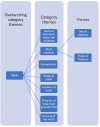What should be included in case report forms? Development and application of novel methods to inform surgical study design: a mixed methods case study in parastomal hernia prevention
- PMID: 36198447
- PMCID: PMC9535162
- DOI: 10.1136/bmjopen-2022-061300
What should be included in case report forms? Development and application of novel methods to inform surgical study design: a mixed methods case study in parastomal hernia prevention
Abstract
Objectives: To describe the development and application of methods to optimise the design of case report forms (CRFs) for clinical studies evaluating surgical procedures, illustrated with an example of abdominal stoma formation.
Design: (1) Literature reviews, to identify reported variations in surgical components of stoma formation, were supplemented by (2) intraoperative qualitative research (observations, videos and interviews), to identify unreported variations used in practice to generate (3) a 'long list' of items, which were rationalised using (4) consensus methods, providing a pragmatic list of CRF items to be captured in the Cohort study to Investigate the Prevention of parastomal HERnias (CIPHER) study.
Setting: Two secondary care surgical centres in England.
Participants: Patients undergoing stoma formation, surgeons undertaking stoma formation and stoma nurses.
Outcome measures: Successful identification of key CRF items to be captured in the CIPHER study.
Results: 59 data items relating to stoma formation were identified and categorised within six themes: (1) surgical approach to stoma formation; (2) trephine formation; (3) reinforcing the stoma trephine with mesh; (4) use of the stoma as a specimen extraction site; (5) closure of other wounds during the procedure; and (6) spouting the stoma.
Conclusions: This study used multimodal data collection to understand and capture the technical variations in stoma formation and design bespoke CRFs for a multicentre cohort study. The CIPHER study will use the CRFs to examine associations between the technical variations in stoma formation and risks of developing a parastomal hernia.
Trial registration number: ISRCTN17573805.
Keywords: colorectal surgery; epidemiology; qualitative research; surgery.
© Author(s) (or their employer(s)) 2022. Re-use permitted under CC BY. Published by BMJ.
Conflict of interest statement
Competing interests: None declared.
Figures
References
-
- Ritchie J, Lewis J, Lewis P. Qualitative research practice: a guide for social science students and researchers. SAGE, 2013.
Publication types
MeSH terms
Grants and funding
LinkOut - more resources
Full Text Sources


